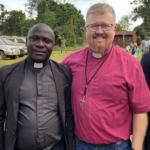
3 Common Barriers To Effective Ministry

A Case For Anglican Church Revitalization Part 2
Changing worship patterns is the aspect of church revitalization that creates the most problems. But if churches are going to commit to the revitalization, then the starting place has to be honest assessment of the potential barriers in place to the process.
In my previous post, A Case for Anglican Church Revitalization, I laid out a working definition of church revitalization — “the missional work of turning a plateau or rapidly declining church around and moving it back towards growth.” Revitalization requires brute honesty and that is difficult. So in this post, I want to lay out three barriers I have encountered in the first few years of ministry.
Barrier #1 — Braying Sacred Cows
It doesn’t matter which denomination I have served under, every local congregation has a sacred cow — an individual, organization, institution, etc., considered to be exempt from criticism or questioning (Dictionary.com). Braying is the ugly noise a cow makes when agitate or distressed. Put these two ideas together and you get a clear picture.
Within Anglicanism, sacred cows usually appear in the form of liturgical artifacts — preferential vestments, ceremonial forms, liturgical icons, traditions, etc. Sacred cows might not be any of the these but could be the flavor of coffee or favorite program. However, when these are questioned or criticized, problems or misunderstandings develop.
Most often, however, sacred cows manifest themselves in the weekly set pattern of worship. This is particularly problematic for generations who spent most of their lives worshipping in one particular form. Chronological age is not necessarily the issue but rather a mindset that can not accept anything else as legitimate. In fact, people who decry change typically do it because the liturgical change violates their expectations of how a service ought to be formed.
Much to my dismay, rarely are critics of change referencing specific tenets of theology or missiology — the only valid reason to be overtly concerned with “changing” liturgy. Usually, tradition is the main reason for questioning any format change. “This is the way we have always done it.” Or even worse, “I prefer this or that liturgy and will not accept any alternative.” These comments are the typical sounds of a braying sacred cow.
A simple illustration, if in response to a minister declaring “the Lord be with you” your custom has been to say “and also with you,” then adjusting to “and with your spirit” may create enough dissonance within a congregation that it is simply agitating. If a minister tries to change this response from one to another, some kind of conflagration usually emerges, “and also with your spirit you.” This will work for a little while but could lead to problems down the road.
Deeply engrained liturgical patterns are difficult, if not impossible for some to let go of. But if you patiently minister without compromise, some folks can overtime learn to appreciate new forms.
J.I. Packer was credited with the following statement:
“Good theology leads to doxology.”
We must remember this principle. Liturgy is not about congregational preference. Rather it is about spiritual formation. When personal preference of worship styles is placed in priority over spiritual formation, then spiritual stagnation results stunting the revitalization process.
Here’s a tip:
Sacred cows need to be put down — but only when missiology or theology or both is at risk.
Barrier #2 — Which priest do I listen too?
Here is a wise saying.
“Wherever two or more clergy are gathered together, usually there is a split.”
Theological differences representing different schools of thought abound throughout the Anglican landscape. The so-called “3 Streams Movement” (Evangelical, Charismatic, Catholic) hasn’t helped in any truly meaningful way to form any real sense of theological cohesion. But rather seems to be a compromise difficult if not impossible to maintain. Within the local congregation, usually one of the three emerges as a dominant current at the expense of the other two.
This does however lead to significant problems for the local church.
Here is a simple example. Consider the differences in the ACNA communion liturgies between the phrasing options of the Fraction.
“Christ has been sacrificed for us once for all upon the cross,” an evangelical may argue.
“Christ is sacrificed for us,” an anglo catholic responds.
The difference between has been and is carries significant theological intent.
Understanding how the verb “to be” relates to the finished work of Jesus Christ on the cross and what the verb tense communicates regarding that work represents a theological division as vast as the differences between has been “present perfect progressive tense” and is “present tense.” Here the use of English grammar is important because of the underlying theology in view — whether or not Holy Communion should be represented from a Protestant view or Roman view. From this point, sacramental theology goes on to form all the other liturgical practices.
When debate on grammar reaches this level, you can be sure that significant discord is at work. Ceremonial differences, arguments over whether or not a rector is-a-pastor or is-a-priest, factions over vestments, conflicting views of Holy Communion and musical style issues, creates significant barriers that must be carefully worked through by each local congregation.
When a congregation has sat under Rectors who represent differing schools of thought (Anglo-Catholic vs. Evangelical), confusion and frustration inevitably occurs. This is a problem that genuinely will plague Anglican parishes unless diligent work is applied by the rector. Sometimes the parish and the rector are at simple odds with one another. The best thing for each is for the rector to move on to another ministry assignment.
Barrier #3 – The Antique Language Trap
This is really a sub-point of the other two, but because of its unique expression within Anglican parishes, Barrier #3 deserves its own consideration.
The fear of change, the need for theological safeguards, and the never ending threat of theological liberalism worming its way into our churches has somehow led to the curious rise for preferring antique language. That is, esteeming a particular “prayerbook” because it contains “higher” linguistic forms or represents a theological apex. This most commonly appears in statements like, we are a 1928 prayerbook church.
Antique Language preferences usually are held by those who try to argue for the “superiority of language” over against modern linguistic forms. The logic is articulated that “thee’s” and “thy’s” and “vouchsafeth’s” are a higher language form because they are poetic use of the english language. Because the language is higher, we should be offer our very best in worship to God. Clearly the use of “thou oh Lord” carries a gravitas that “you oh Lord” can not accomplish in its place (tongue-in-cheek).
There are also advocates for returning to the language and forms of the 1662 BCP. Advocates for this form rarely make poetic arguments as above, but instead are more concerned with theological precision. Because of later theological shifts within certain pockets of Anglicanism (i.e. Anglo-catholicism) coupled with the liberal theology of the 21st century, 1662 advocates desire to recapture the traditional forms for the sake of communicating theological truths. The motive is a good one because it reflects Packer’s argument.
However, just because language is poetic, does not necessarily mean it is “higher” and just because it may be theologically precise doesn’t mean it is effective. If the language is unrecognizable, then it is a barrier in communicating the gospel — witness the rise of many different bible translations.
There is an inherent danger to both strategies. Because we no longer use the word “thou” in everyday speech, the word “thou” has been relegated linguistically to sacramental speech alone. It is by street standards an antique word. By adopting “antique” forms of language, we may be committing the same mistake as the medieval church — removing worship from the common person by setting up a language barrier.
This was the genius of Archbishop Thomas Cranmer and the 16th century Anglican divines. At a time when Latin was the liturgical standard, Cranmer wrote prayers and services in the tongue of the common english person.






